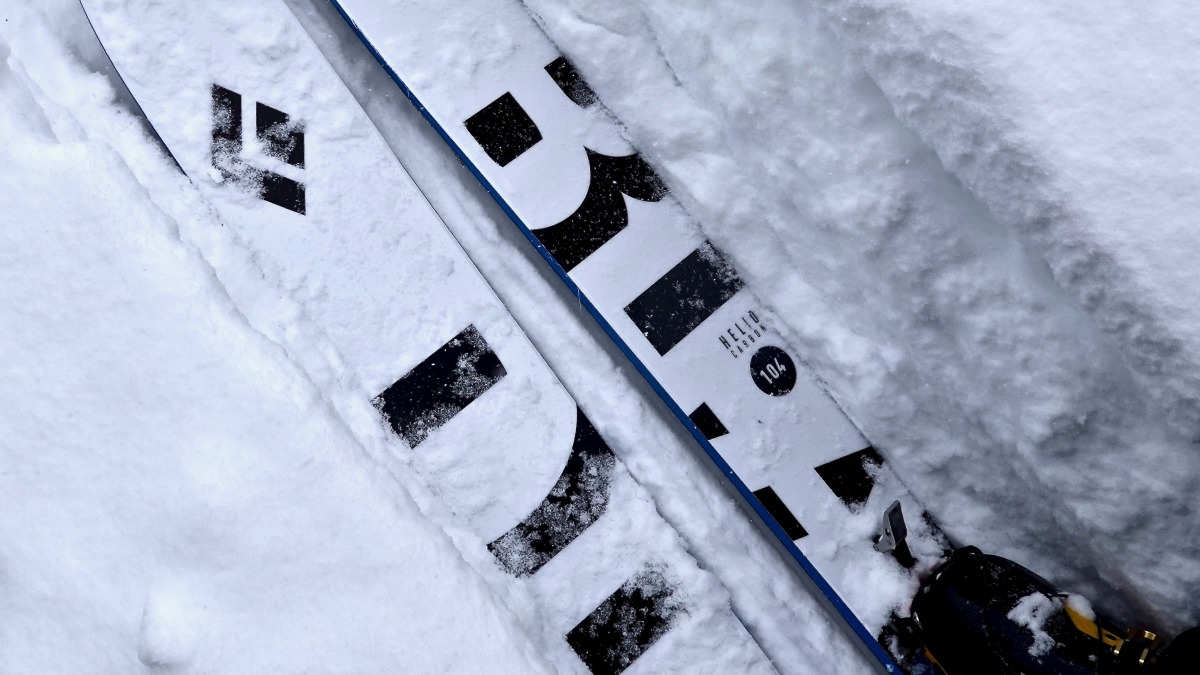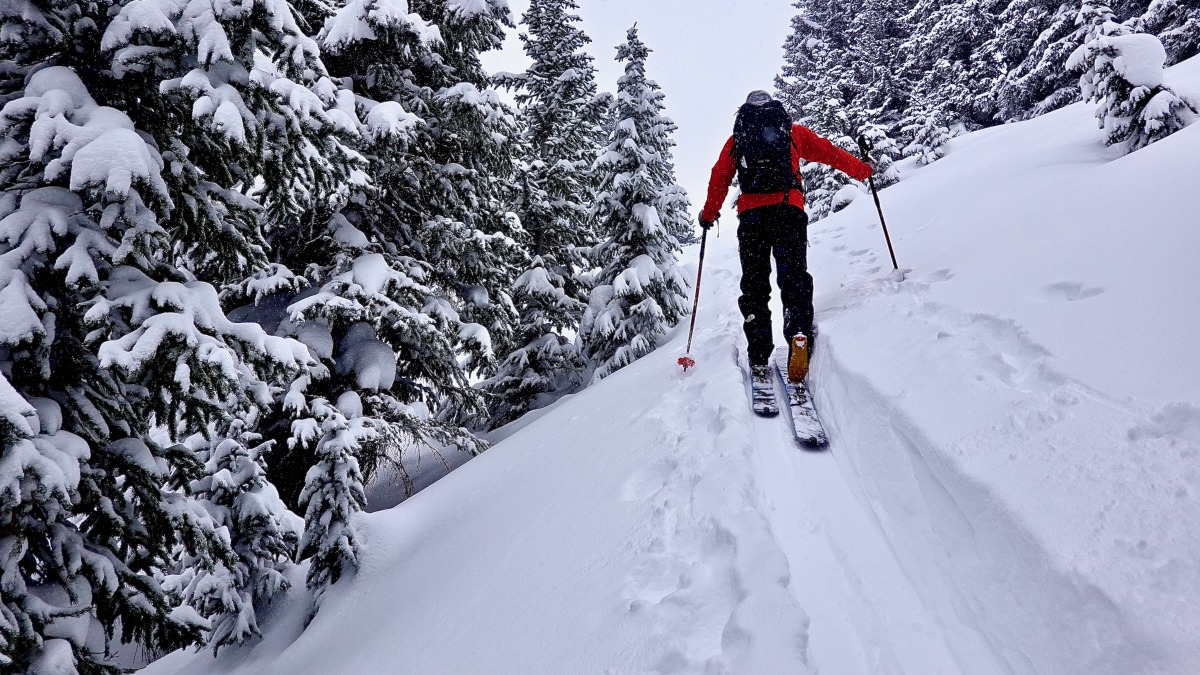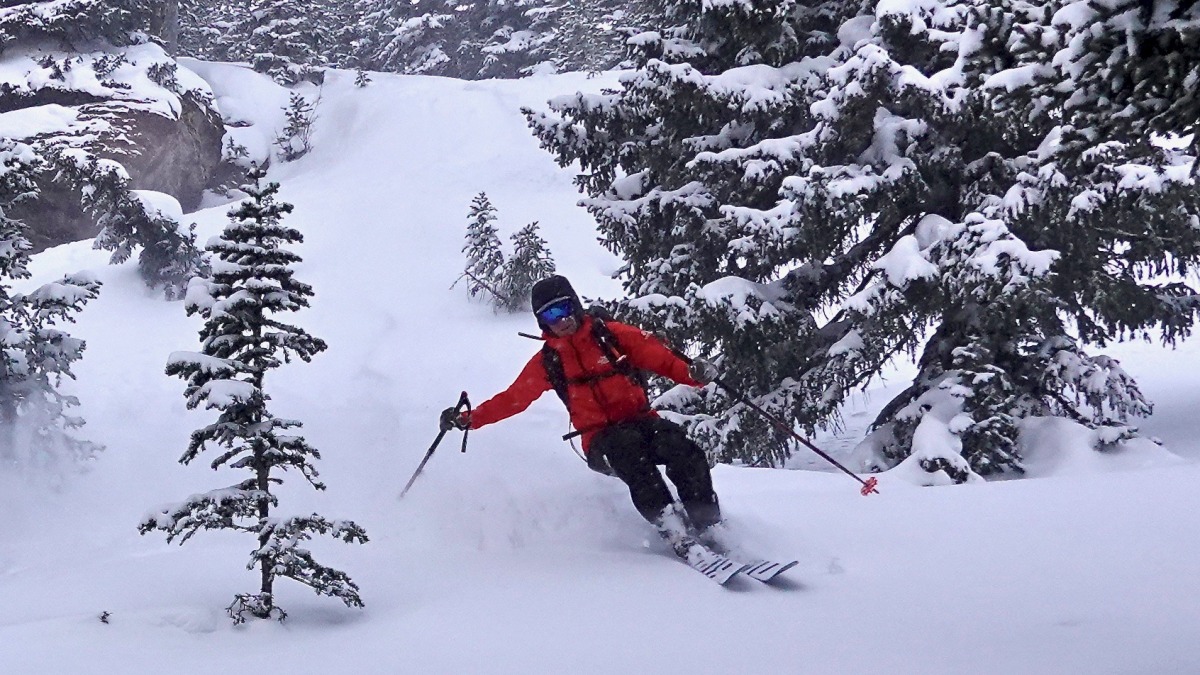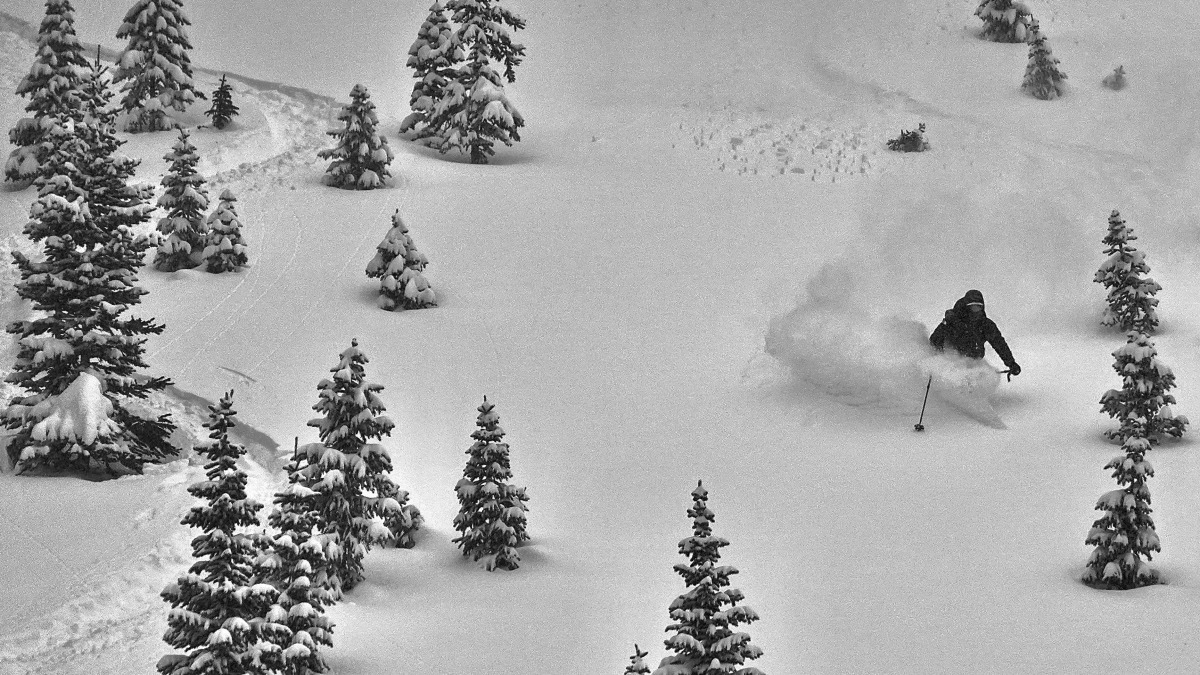
The forthcoming Helio Carbon 104 where it shines, in a deeply trenched skin track lapping pristine powder.
Thermometers read nill one Tuesday morning in early February with no relief in sight. Forecasts called for steady temperatures and snowfall throughout the day in addition to the seven inches that fell overnight at the local ski hill. I set up my crew at the day’s job site in the East Vail neighborhood and dipped away with a pair of 20/21 Black Diamond Helio Carbon 104s in tow. Playing hookie for storm skiing is a sacred tradition for a small business owner in a ski town and one I intend to keep the tradition alive and well.
It’s no secret that the pistes of Vail are an often crowded mess. The steep and shady lift accessed backcountry terrain above the East Vail neighborhood that collects Little Cottonwood-like snow totals have also lost their secrecy, regularly seeing over 200 skiers per day. My partner and I planned to use the ski area’s chair lifts to access that same snowy micro-climate, only in a different zone that required a more human powered approach to access the wild snow.
As I walked through the faux Bavarian village on the side of I-70, I found the shoulder weight of the Helio 104s to be encouraging; they would no doubt make the deep trail breaking portion of our day easier. The weight of the 178cm is listed as 1,450g, putting these 184cm skis somewhere in the high 1,500g range. An impressive weight to surface area ratio for this ski with 132-104-108mm width dimensions and a full wrap ABS sidewall. BD accomplishes said weight with an engineered paulownia core and pre-preg carbon fiber layup. The paulownia core is the main difference in these forthcoming Helios from previous iterations, transitioning away from the slightly less solid balsa-flax core in the current line.
My partner for the day was good friend and former ski patrol cohort Joe Golting. He and I quickly traversed across Vail’s famous back bowls, passing on powder turns that other folks may fly across the world for. That 7-10 inches atop crowd-sourced bumps would be 12-15 inches on top of 6 feet of lightly settled north facing base in our intended zone. We set out beyond the ski area boundary and put in a contouring skin track towards the powder, needing to gain only 1,000 feet over almost 2 miles.
Our playground for the day was a short (600’ vert) bowl near and below treeline. The paths and hallways through the trees quickly roll to near 40 degrees and mellow out abruptly into a large open meadow below. On arrival, we chose an appropriate first line given the moderate-moderate-low avalanche forecast, one that had a simple test slope and was more protected from winds. I rolled into perfectly spaced conifers and immediately knew that my day of hookie was justified. The 132mm wide shovel responded well to being driven, and I was soon exclaiming those familiar joyous calls of a powder skier nestled between over the shoulder walls of snow. Joe was shortly behind, face plastered with a giant smile and chunks of powder. Time to set the lap track!

Gliding up our recycled trench on the Helio 104s for more snow in the face, somewhere around lap three.
I took on the lionshare of the trailbreaking on this short but knee deep track. The low weight boards with their rockered shovel and mid fat waist were greatly appreciated setting this bottomless track with tricky, steep and deep kick turns. With our track for the day set, we pushed over to the next opening where Joe dropped in first.
Joe is a beautifully effortless skier shaped by a lifetime of ski racing, ski patrolling, and freeskiing. He started skiing at age two, trained as a racer through high school, was a junior olympian, and raced as a Division I collegiate athlete specializing in the Super G. More soul skier than freeride bro, Joe skis strong and conservative, opting to enjoy the perfect turn shape for the conditions over speed and air. I once asked him when the last time he fell while skiing was, and he couldn’t remember, only stating, “I think it happens once every three to four years.” For the record, “it” happens to me to some extent once every ten to fifteen days out.
Watching someone like Joe ski is a free clinic, especially in the possibilities of a true alpine turn. I think many of us would be shocked at how much more you can get out of a ski when it is truly angulated and pressured — and about how far off we are from actually doing that. Especially in an age when many (like myself) have never turned a ski without sidecut. Whenever I ski with Joe, I find myself skiing better simply by visual osmosis. This was a perfect inspiration for the Helio 104s which were incredibly poppy out of the perfectly right side up powder. I channeled my inner ski racer and powered the ski hard each turn in the next hallway in the trees. The tapered shovel initiated turns smoothly while the stiffer and poppy tail powered me out with gusto.

Powering the Helio 104s hard while treating the treetops as lazy backcountry slalom gates. Enough pop in these carbon planks to rip a short radius turn and come all the way up from the knee deep snow in the transition.
We reluctantly left our zone around 3 p.m. without seeing another soul or track, and headed for one of the aforementioned ‘East Vail Chutes’ as an egress. Upon arrival, we lamented the ten to fifteen tracks laid down ahead of us and reminisced over the less tracked “good ol’ days”. Funny because those days for us are only eight or ten years prior — our mentors and predecessors enjoyed a true backcountry experience in this magical nexus of snow totals and terrain.
The Helio Carbon 104s disliked crossing tracks even more than I did. The construction that gives these skis their awesome light weight and pop in pow provided unwanted feedback in less consistent conditions. Rather unfortunate on this last decent given the ever increasing amount of tracks as we descended towards the neighborhood. I think this is a skier preference thing, and wouldn’t rule out the Helio Carbon build for an all around or spring construction for some folks. Black Diamond is not trying to hide that fact either. The current Helio Recon line, updated for this season, trades the paulownia for poplar and the carbon fibers for glass fibers to create a heavier, more damp and solid backcountry ski. I prefer to carry a bit more weight per surface area, such as something like the Recon line, in spring or unknown mountaineering conditions.
A 1500ish gram, mid-100mm waist ski with generous front rocker is, for my tastes, the perfect powder touring plank. Pair them with a minimalist brake-free sub 300 gram binding and a 1000-1300 gram two buckle boot and you have a killer powder harvesting system. BD mounted these tester boards in house with the new Helio 350, a braked version of the Helio 200. I locked the brakes up once we started touring and forgot to unlock that extra 150g for the day- dead weight in my opinion. My boot was the La Sportiva Skorpius — a perfect match for a light yet full sized ski. I love skiing a damp 115mm+ ski with a big four buckle boot, and certainly see the benefits of such, but find those beefier setups best for single descent days or mechanized assists. It is also a treat to zip uphill in a race oriented boot and 1000g narrower ski. I just don’t get the same surfy enjoyment and turn shape options out of small, uber-light planks. The forthcoming Black Diamond Helio Carbon 104 is an excellent option for this multi-lap powder touring class of ski. Now, back to work!
Specs
Weight: 1,450g in 178 cm
Available lengths: 166cm, 172cm, 178cm, 184cm
Dimensions: 132-104-108mm
Core: Paulownia, pre-preg carbon fiber, ABS sidewall
Profile: 334mm Rocker tip, Camber, 242mm Semi Rocker
Turn Radius: 22m
On March 22nd 2021, Gary Smith tragically died in an avalanche outside of Beaver Creek Resort in Colorado. Since 2018, Gary has been a frequent and insightful contributor to WildSnow. From Christmas Eve spent at the Wildsnow Field HQ cabin, to testing gear and sharing his love for steep skiing around the world, he was a pillar of the ski touring community and will be greatly missed.

